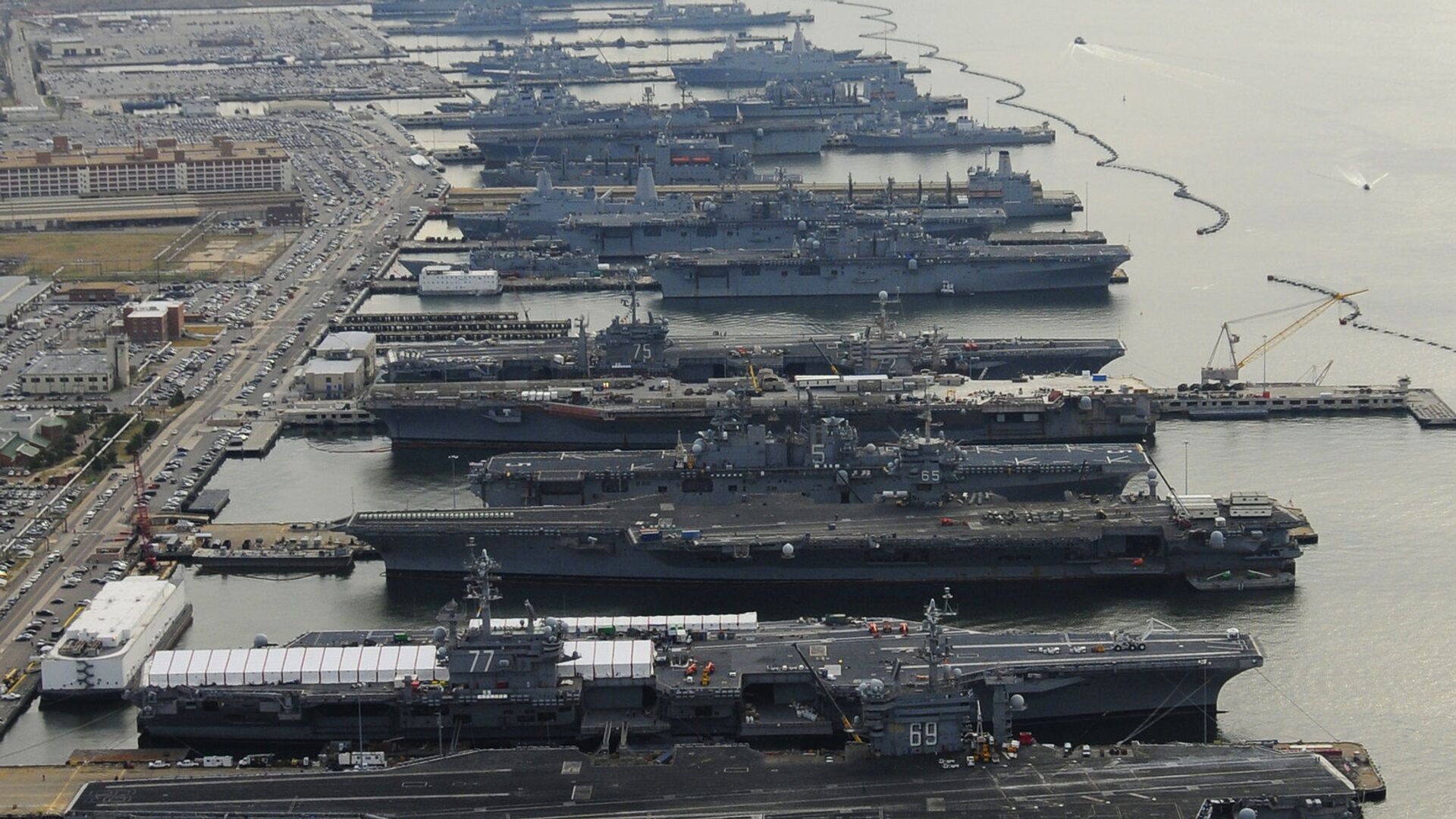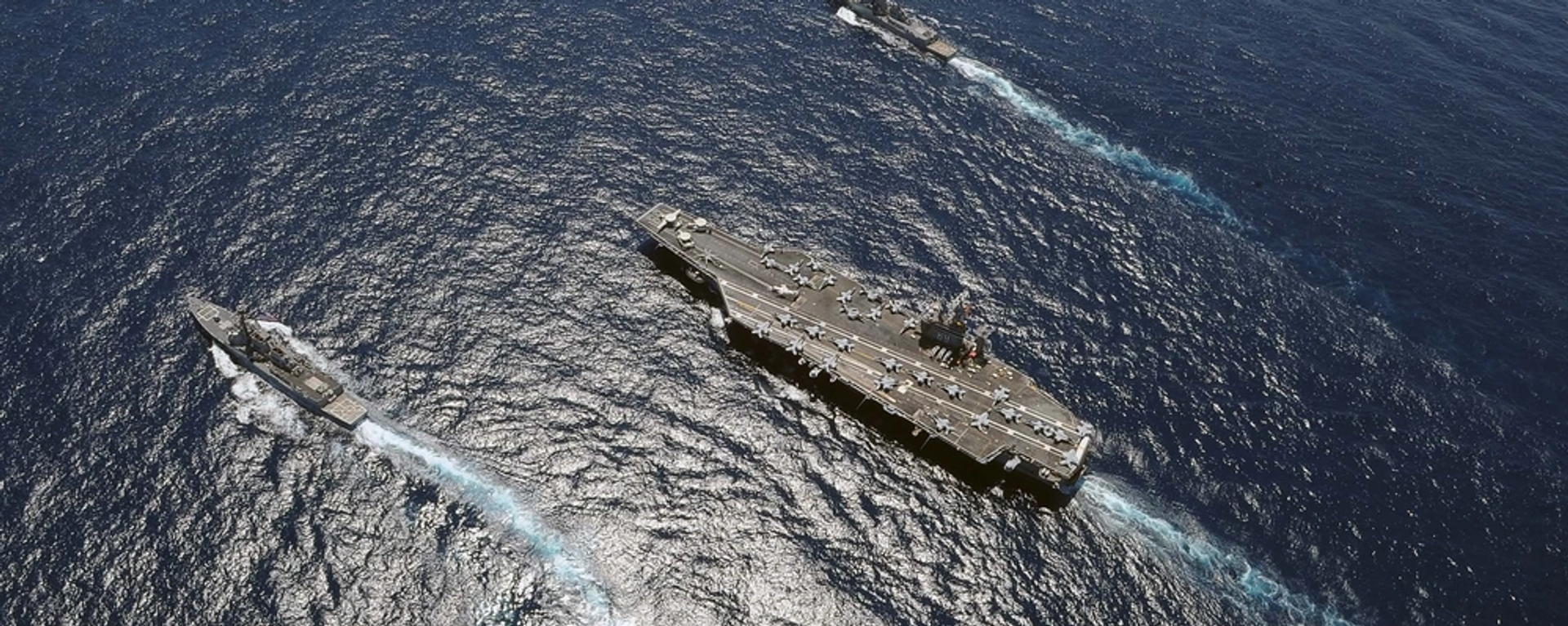https://sputnikglobe.com/20240803/us-media-warns-about-houthi-threat-to-aircraft-carriers-as-tensions-boil-over-in-red-sea-1119627453.html
US Media Warns About Houthi Threat to Aircraft Carriers as Tensions Boil Over in Red Sea
US Media Warns About Houthi Threat to Aircraft Carriers as Tensions Boil Over in Red Sea
Sputnik International
Houthi threats against Israel and the US have grown louder in the past two weeks after an Israeli strike on the Yemeni port Hodeidah, and the killing of Hamas’s chief negotiator in Tehran. The militia has proven more than capable of enforcing a semi-blockade of the Red Sea, and may be just one lucky strike away from sinking a massive US warship.
2024-08-03T19:05+0000
2024-08-03T19:05+0000
2024-08-03T19:29+0000
military
dwight d. eisenhower
military & intelligence
red sea
israel
houthis
houthi
nimitz
uss laboon
red sea crisis
https://cdn1.img.sputnikglobe.com/img/107717/61/1077176127_0:562:1645:1487_1920x0_80_0_0_04a84022a920ce9f60495cbf8ed67d16.jpg
US media have warned about the “alarming” prospects of a multi-billion-dollar Nimitz-class supercarrier being put at risk by technically “unsophisticated” Houthi adversaries.“Despite the aircraft carrier's formidable defenses and advanced technology, the persistence of Houthi harassment has sparked debates about the vulnerability of such vessels in modern combat environments, especially when facing unconventional threats from non-state actors like the Houthis,” National Interest contributor Harrison Kass wrote in a piece published Saturday.“Aircraft carriers are uniquely expensive,” the observer pointed out, citing the Nimitz class’s $6-7 billion dollars apiece price tag, and the newer Ford class’s gargantuan $13 billion per ship cost. That’s not counting the vessels’ 4,600-5,200 crew, or their complement of aircraft, which cost tens of millions of dollars each.The $430,800-$472,000 apiece AIM-9X Sidewinder infrared-guided heat-seeking missiles used to target the Houthis’ $2,000-$20,000 apiece drones and missiles have “proven effective” enough, according to Kass. “Houthi missiles and drones do not likely pose an existential threat to Eisenhower, but the seed of doubt has been planted,” the journalist suggested.Kass’s piece is the latest bit of speculation in Western media about whether the Houthis have the means to destroy an American supercarrier. Last month, Forbes contributor David Hambling urged smug observers not to get too cocky and “take a closer look at the facts before writing off the threat.”Pointing to Soviet and Russian analyses suggesting it would take between 12 and 20+ missiles to kill a US aircraft carrier, and calculations based on the Nimitz-class’s 88,000 metric ton displacement that anywhere between five and 100 warheads would be needed to do so, Hambling warned that “history tells a different story,” and that a lucky strike triggering onboard fires and explosions “does not require a large amount of explosive” to bring about.The observer recalled that only one of the five large carriers lost by the US in World War II was sunk outright, and pointed out that the HMS Sheffield destroyer that sank under tow during the 1982 Falklands War was lost to an Argentine missile which did not detonate, but managed to start a fire, setting off munitions stocks onboard. The same problem may have afflicted the Moskva missile cruiser in 2022, according to Hambling.“It seems highly unlikely that the Houthis will damage any US carrier. But history has repeatedly shown that defensive measures which look unbeatable on paper can fail due to human error…Confidence is justified, complacency is not. And moving even the mightiest supercarrier into an area where it may be attacked is not without risk,” the observer emphasized.And even if the militia cannot effectively sink the Eisenhower, it could work out how many small drones are needed to prevent its effective operation.The threat posed by the Houthis to large US warships has been hinted at recently by USS Laboon destroyer commander Eric Blomberg.
https://sputnikglobe.com/20240727/us-navy-drops-details-on-pricey-missiles-and-bombs-its-using-against-yemens-warriors-1119534456.html
https://sputnikglobe.com/20240719/houthis-long-arm-what-we-know-about-militias-drone-fleet-1119432209.html
https://sputnikglobe.com/20240711/pro-pentagon-media-calls-on-dod-to-step-up-anti-houthi-info-war-amid-blows-to-us-navys-reputation-1119342599.html
red sea
israel
Sputnik International
feedback@sputniknews.com
+74956456601
MIA „Rossiya Segodnya“
2024
News
en_EN
Sputnik International
feedback@sputniknews.com
+74956456601
MIA „Rossiya Segodnya“
Sputnik International
feedback@sputniknews.com
+74956456601
MIA „Rossiya Segodnya“
can houthis sink aircraft carriers, how can an aircraft carrier sink, are us aircraft carriers vulnerable, what are us aircraft carriers' vulnerabilities
can houthis sink aircraft carriers, how can an aircraft carrier sink, are us aircraft carriers vulnerable, what are us aircraft carriers' vulnerabilities
US Media Warns About Houthi Threat to Aircraft Carriers as Tensions Boil Over in Red Sea
19:05 GMT 03.08.2024 (Updated: 19:29 GMT 03.08.2024) Houthi threats against Israel and the US have grown louder in the past two weeks after an Israeli strike on the Yemeni port Hodeidah, and the killing of Hamas’s chief negotiator in Tehran. The militia has proven more than capable of enforcing a semi-blockade of the Red Sea, and may be just one lucky strike away from sinking a massive US warship.
US media have warned about the “alarming” prospects of a multi-billion-dollar Nimitz-class supercarrier being put at risk by technically “unsophisticated” Houthi adversaries.
“Despite the aircraft carrier's formidable defenses and advanced technology, the persistence of Houthi harassment has sparked debates about the vulnerability of such vessels in modern combat environments, especially when facing unconventional threats from non-state actors like the Houthis,” National Interest contributor Harrison Kass
wrote in a piece published Saturday.
“Aircraft carriers are uniquely expensive,” the observer pointed out, citing the Nimitz class’s $6-7 billion dollars apiece price tag, and the newer Ford class’s gargantuan $13 billion per ship cost. That’s not counting the vessels’ 4,600-5,200 crew, or their complement of aircraft, which cost tens of millions of dollars each.
“The aircraft carrier is a tool of great power politics. It is a floating city capable of delivering airpower around the world. The Americans built their aircraft carrier [fleet] with world powers like Russia and China in mind. Houthi rebels, not so much. Yet, the Houthis seem bent on harassing the Eisenhower,” Kass recalled, pointing to
media reports from earlier this summer of the carrier’s crew becoming fatigued after experiencing its “most intense running sea battle since World War II.”
The
$430,800-$472,000 apiece AIM-9X Sidewinder infrared-guided heat-seeking missiles used to target the Houthis’ $2,000-$20,000 apiece drones and missiles have “proven effective” enough, according to Kass. “Houthi missiles and drones do not likely pose an existential threat to Eisenhower, but the seed of doubt has been planted,” the journalist suggested.
Kass’s piece is the latest bit of speculation in Western media about whether the Houthis have the means to destroy an American supercarrier. Last month, Forbes contributor David Hambling
urged smug observers not to get too cocky and “take a closer look at the facts before writing off the threat.”
Pointing to Soviet and Russian analyses suggesting it would take between 12 and 20+ missiles to kill a US aircraft carrier, and calculations based on the Nimitz-class’s 88,000 metric ton displacement that anywhere between five and 100 warheads would be needed to do so, Hambling warned that “history tells a different story,” and that a lucky strike triggering onboard fires and explosions “does not require a large amount of explosive” to bring about.
The observer recalled that only one of the five large carriers lost by the US in World War II was sunk outright, and pointed out that the HMS Sheffield destroyer that sank under tow during the 1982 Falklands War was lost to an Argentine missile which did not detonate, but managed to start a fire, setting off munitions stocks onboard. The same problem may have afflicted the Moskva missile cruiser in 2022, according to Hambling.
“The lesson,” Hambling says, is that “it is not the size of the incoming warhead which determines the damage,” but “the risk of stored ammunition becoming a self-destruct charge.”
“It seems highly unlikely that the Houthis will damage any US carrier. But history has repeatedly shown that defensive measures which look unbeatable on paper can fail due to human error…Confidence is justified, complacency is not. And moving even the mightiest supercarrier into an area where it may be attacked is not without risk,” the observer emphasized.
And even if the militia cannot effectively sink the Eisenhower, it could work out how many small drones are needed to prevent its effective operation.
The threat posed by the Houthis to large US warships has been hinted at recently by USS Laboon destroyer commander Eric Blomberg.
“I don’t think people really understand just kind of how deadly serious it is what we’re doing and how under threat the ships continue to be,” Blomberg said in an AP interview in June. “We only have to get it wrong once. The Houthis just have to get one through.”





